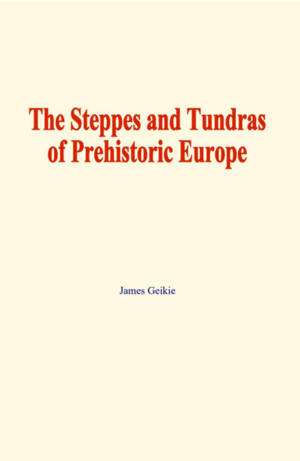
- Retrait gratuit dans votre magasin Club
- 7.000.000 titres dans notre catalogue
- Payer en toute sécurité
- Toujours un magasin près de chez vous
- Retrait gratuit dans votre magasin Club
- 7.000.0000 titres dans notre catalogue
- Payer en toute sécurité
- Toujours un magasin près de chez vous
The Steppes and Tundras of prehistoric Europe EBOOK
Lois intellectuelles du langage
James Geikie
Ebook | Anglais
6,99 €
+ 6 points
Description
We are all familiar with the general conclusion arrived at by geologists that our earth has experienced many climatic changes. There have been times when genial conditions ranged up to the highest latitudes, and times also when the cold of the arctic regions descended to what is now our temperate zone. The cause or causes of those remarkable vicissitudes still baffle research. Many explanations have been advanced, some highly improbable, others perhaps more likely, while of yet others it may be said that possibly they contain a certain amount of truth. But no one theory or hypothesis has succeeded in gaining general assent, and we shall not therefore at present concern ourselves with any. In place of reviewing hypotheses and speculations, I shall limit myself to a survey of certain facts connected with the later geological history of our continent, the meaning of which is more or less apparent. The evidence referred to leads to the conclusion that Middle Europe has within the human period experienced conditions such, as now obtain in the tundras and barren grounds of circumpolar regions. When these conditions passed away, the central and west-central areas of our continent became steppe lands, comparable as regards climate to the subarctic steppes of southeast Russia and southwest Siberia.
As geologists reason from the present to the past, it will be well to take first a brief glance at those regions of the globe where at present tundra and steppe conditions respectively prevail. When we have realized the salient characters of those regions, and the nature of their floras and faunas, we shall be in a better position to understand the bearing of the geological evidence.
ABOUT THE AUTHOR
James Geikie (1839–1915) was a Scottish geologist and younger brother of Sir Archibald Geikie. He also made significant contributions to the field of geology.
As geologists reason from the present to the past, it will be well to take first a brief glance at those regions of the globe where at present tundra and steppe conditions respectively prevail. When we have realized the salient characters of those regions, and the nature of their floras and faunas, we shall be in a better position to understand the bearing of the geological evidence.
ABOUT THE AUTHOR
James Geikie (1839–1915) was a Scottish geologist and younger brother of Sir Archibald Geikie. He also made significant contributions to the field of geology.
Spécifications
Parties prenantes
- Auteur(s) :
- Editeur:
Contenu
- Langue:
- Anglais
Caractéristiques
- EAN:
- 9782381116198
- Date de parution :
- 07-02-23
- Format:
- Ebook
- Protection digitale:
- /
- Format numérique:
- ePub

Les avis
Nous publions uniquement les avis qui respectent les conditions requises. Consultez nos conditions pour les avis.






